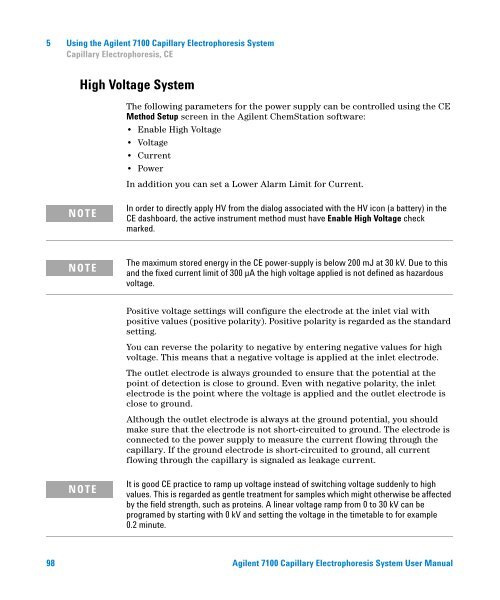Introduction to the Agilent 7100 Capillary Electrophoresis System
Introduction to the Agilent 7100 Capillary Electrophoresis System
Introduction to the Agilent 7100 Capillary Electrophoresis System
You also want an ePaper? Increase the reach of your titles
YUMPU automatically turns print PDFs into web optimized ePapers that Google loves.
5 Using <strong>the</strong> <strong>Agilent</strong> <strong>7100</strong> <strong>Capillary</strong> <strong>Electrophoresis</strong> <strong>System</strong><br />
<strong>Capillary</strong> <strong>Electrophoresis</strong>, CE<br />
High Voltage <strong>System</strong><br />
The following parameters for <strong>the</strong> power supply can be controlled using <strong>the</strong> CE<br />
Method Setup screen in <strong>the</strong> <strong>Agilent</strong> ChemStation software:<br />
• Enable High Voltage<br />
• Voltage<br />
• Current<br />
• Power<br />
In addition you can set a Lower Alarm Limit for Current.<br />
NOTE<br />
In order <strong>to</strong> directly apply HV from <strong>the</strong> dialog associated with <strong>the</strong> HV icon (a battery) in <strong>the</strong><br />
CE dashboard, <strong>the</strong> active instrument method must have Enable High Voltage check<br />
marked.<br />
NOTE<br />
The maximum s<strong>to</strong>red energy in <strong>the</strong> CE power-supply is below 200 mJ at 30 kV. Due <strong>to</strong> this<br />
and <strong>the</strong> fixed current limit of 300 µA <strong>the</strong> high voltage applied is not defined as hazardous<br />
voltage.<br />
Positive voltage settings will configure <strong>the</strong> electrode at <strong>the</strong> inlet vial with<br />
positive values (positive polarity). Positive polarity is regarded as <strong>the</strong> standard<br />
setting.<br />
You can reverse <strong>the</strong> polarity <strong>to</strong> negative by entering negative values for high<br />
voltage. This means that a negative voltage is applied at <strong>the</strong> inlet electrode.<br />
The outlet electrode is always grounded <strong>to</strong> ensure that <strong>the</strong> potential at <strong>the</strong><br />
point of detection is close <strong>to</strong> ground. Even with negative polarity, <strong>the</strong> inlet<br />
electrode is <strong>the</strong> point where <strong>the</strong> voltage is applied and <strong>the</strong> outlet electrode is<br />
close <strong>to</strong> ground.<br />
Although <strong>the</strong> outlet electrode is always at <strong>the</strong> ground potential, you should<br />
make sure that <strong>the</strong> electrode is not short-circuited <strong>to</strong> ground. The electrode is<br />
connected <strong>to</strong> <strong>the</strong> power supply <strong>to</strong> measure <strong>the</strong> current flowing through <strong>the</strong><br />
capillary. If <strong>the</strong> ground electrode is short-circuited <strong>to</strong> ground, all current<br />
flowing through <strong>the</strong> capillary is signaled as leakage current.<br />
NOTE<br />
It is good CE practice <strong>to</strong> ramp up voltage instead of switching voltage suddenly <strong>to</strong> high<br />
values. This is regarded as gentle treatment for samples which might o<strong>the</strong>rwise be affected<br />
by <strong>the</strong> field strength, such as proteins. A linear voltage ramp from 0 <strong>to</strong> 30 kV can be<br />
programed by starting with 0 kV and setting <strong>the</strong> voltage in <strong>the</strong> timetable <strong>to</strong> for example<br />
0.2 minute.<br />
98 <strong>Agilent</strong> <strong>7100</strong> <strong>Capillary</strong> <strong>Electrophoresis</strong> <strong>System</strong> User Manual
















